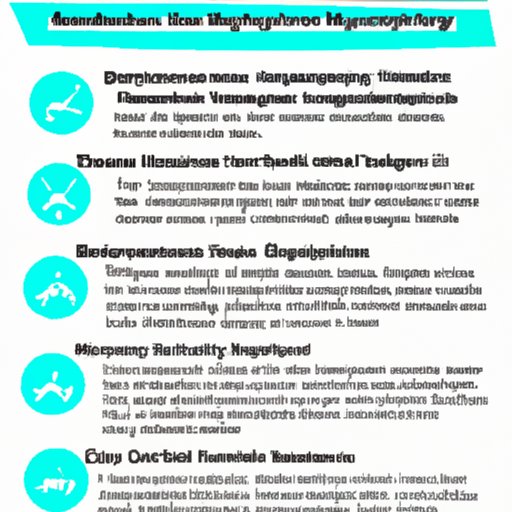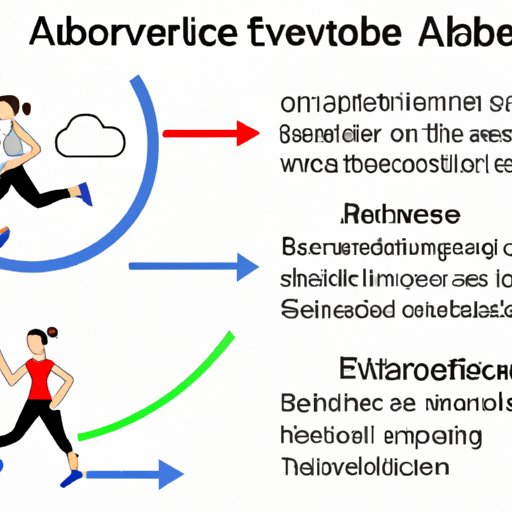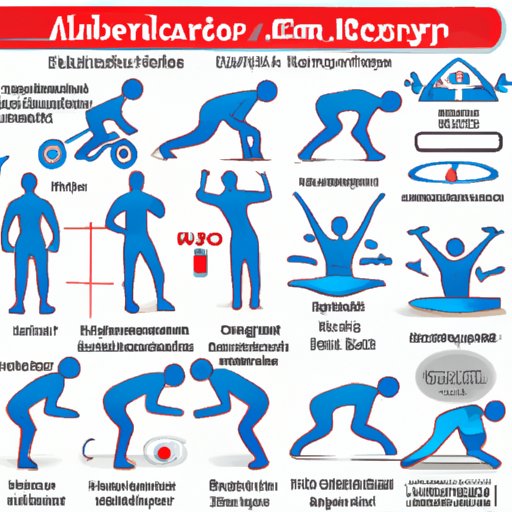Introduction
Exercise plays an important role in maintaining physical and mental health. But with so many different types of exercises out there, it can be difficult to know which one is right for you. Two popular types of exercise are aerobic and anaerobic exercise, but what’s the difference? This article will explore the differences between these two types of exercise, their benefits, and how to find the right balance for maximum health benefits.

Definition of Aerobic and Anaerobic Exercise
Aerobic exercise is any type of exercise that uses oxygen to fuel the body. These activities typically involve continuous, rhythmic movements such as running, swimming, or cycling. The goal of aerobic exercise is to increase your heart rate and breathing rate for an extended period of time, usually 20 minutes or more. This type of exercise is great for improving cardiovascular health and burning calories.
Anaerobic exercise is any type of exercise that does not use oxygen to fuel the body. Unlike aerobic exercise, anaerobic exercise involves short bursts of intense activity, such as sprinting, lifting weights, or high-intensity interval training (HIIT). The goal of anaerobic exercise is to increase strength, power, and muscle mass.

Overview of Benefits of Each Type of Exercise
Both aerobic and anaerobic exercise provide numerous health benefits. According to Dr. Daniel Vigil, a professor in the Departments of Family Medicine and Orthopaedic Surgery at UCLA, “Aerobic exercise helps reduce the risk of heart disease, stroke, and diabetes, while anaerobic exercise helps build and maintain muscle mass and strength.”
In addition to these benefits, aerobic exercise has been shown to improve sleep quality, reduce stress, and boost mood. Anaerobic exercise, on the other hand, can help improve bone density, prevent injuries, and improve sports performance.
Side-by-Side Comparison of Aerobic and Anaerobic Exercise
When comparing aerobic and anaerobic exercise, there are four main factors to consider: intensity level, duration, energy sources used, and muscles involved.
Intensity Level
The intensity level of aerobic exercise is usually lower than that of anaerobic exercise. During aerobic exercise, your heart rate should remain between 50 and 70 percent of your maximum heart rate. For anaerobic exercise, your heart rate should reach 90 to 100 percent of your maximum heart rate.
Duration
The duration of aerobic exercise is typically longer than that of anaerobic exercise. Aerobic exercise should be performed for at least 20 minutes at a time, while anaerobic exercise should be done in short bursts of 30 seconds to 2 minutes.
Energy Sources Used
Aerobic exercise uses oxygen to produce energy, while anaerobic exercise does not. During aerobic exercise, your body breaks down glucose and fatty acids to produce energy. During anaerobic exercise, your body breaks down stored glycogen to produce energy.
Muscles Involved
Aerobic exercise typically involves larger muscle groups, such as those in the legs and chest. Anaerobic exercise usually involves smaller muscle groups, such as those in the arms and core.
Exploring the Pros and Cons of Aerobic vs Anaerobic Exercise
While both aerobic and anaerobic exercise offer numerous health benefits, they each have their own potential drawbacks. Let’s take a closer look at the pros and cons of each type of exercise.
Benefits of Aerobic Exercise
The primary benefit of aerobic exercise is improved cardiovascular health. According to a study published in the journal Circulation, regular aerobic exercise can lower blood pressure, improve cholesterol levels, and reduce the risk of type 2 diabetes. Other benefits of aerobic exercise include increased lung capacity, stronger bones, and improved mental health.
Benefits of Anaerobic Exercise
The primary benefit of anaerobic exercise is increased muscle strength and power. According to a study published in the journal Sports Medicine, regular anaerobic exercise can lead to increased muscle size and strength, improved coordination, and increased speed and agility. Other benefits of anaerobic exercise include improved bone density, enhanced sports performance, and improved body composition.
Potential Drawbacks of Aerobic Exercise
The primary potential drawback of aerobic exercise is the risk of overtraining. If you don’t give your body adequate rest between workouts, you may experience fatigue, muscle soreness, and injury. Additionally, some people may find long bouts of aerobic exercise boring or monotonous.
Potential Drawbacks of Anaerobic Exercise
The primary potential drawback of anaerobic exercise is the risk of injury. Without proper form and technique, anaerobic exercises can put excessive strain on your joints and muscles, leading to injury. Additionally, some people may find high-intensity anaerobic exercises too difficult or intimidating.

An Overview of Aerobic and Anaerobic Exercise and Their Benefits
Aerobic and anaerobic exercise both offer numerous health benefits. Regular aerobic exercise can improve cardiovascular health, reduce stress, and boost mood, while regular anaerobic exercise can improve muscle strength and power, enhance sports performance, and improve body composition.
What You Need to Know About Aerobic and Anaerobic Exercise
In order to get the most out of your workout, it’s important to understand the differences between aerobic and anaerobic exercise and how to combine them for maximum health benefits. Here are some guidelines for safe and effective exercise.
Benefits of Combining Both Types of Exercise
Combining both aerobic and anaerobic exercise is the best way to optimize your fitness routine. A balanced program of aerobic and anaerobic exercise can help you achieve your fitness goals faster and more effectively. For example, combining aerobic exercise with strength training can help you burn fat and build muscle at the same time.
Guidelines for Safe Exercise
It’s important to follow safety guidelines when performing any type of exercise. Make sure to warm up before exercise and cool down after. Additionally, it’s important to monitor your heart rate and breathing rate during exercise and stop if you feel any pain or discomfort.
Finding the Right Balance of Aerobic and Anaerobic Exercise
Finding the right balance of aerobic and anaerobic exercise is key to getting the most out of your workout. Generally, it’s recommended to do at least 150 minutes of moderate-intensity aerobic exercise per week, plus two or three days of strength training or other anaerobic exercise. However, it’s important to find the balance that works best for you.
Comparing Aerobic and Anaerobic Exercise for Maximum Health Benefits
Now that you understand the differences between aerobic and anaerobic exercise, let’s take a look at some best practices for getting the most out of your workout.
Best Practices for Getting the Most Out of Your Workout
To get the most out of your workout, it’s important to vary your routine. Try incorporating different types of aerobic and anaerobic exercise into your weekly routine, such as running, swimming, weightlifting, and HIIT. Additionally, make sure to give your body adequate rest between workouts to avoid overtraining.
Knowing When to Incorporate More of One Type of Exercise
If you’re looking to lose weight or improve your cardiovascular health, focus on aerobic exercise. If you’re looking to build muscle or improve your sports performance, focus on anaerobic exercise. Additionally, if you’re new to exercise, start with low-intensity aerobic exercise and gradually add more intensity and variety as you become more comfortable and confident.
The Difference Between Aerobic and Anaerobic Exercise: What Works Best for You?
When deciding which type of exercise is right for you, there are several factors to consider. Think about your fitness goals, current fitness level, and available time and resources. Additionally, consider your lifestyle and personal preferences. Do you prefer low-intensity, steady state activities or high-intensity, intermittent activities? Understanding your own goals and needs will help you determine the best type of exercise for you.
Conclusion
When it comes to exercise, there’s no one-size-fits-all approach. Aerobic and anaerobic exercise each offer unique benefits, and the best way to maximize your health and fitness is to find the right balance of both. By understanding the differences between these two types of exercise and creating a personalized fitness plan, you can ensure you’re getting the most out of your workout.
(Note: Is this article not meeting your expectations? Do you have knowledge or insights to share? Unlock new opportunities and expand your reach by joining our authors team. Click Registration to join us and share your expertise with our readers.)
